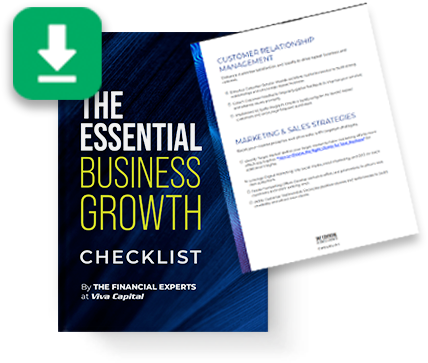
According to the latest Federal Reserve Banks Small Business Credit Survey, business line of credit (LOC) applications account for two out of every five funding requests made by small businesses. This places it only modestly behind traditional business loans as the most popular business financing option.
If your company is experiencing a cash flow lull and requires funds to manage daily business or operating expenses, purchase inventory, or improve growth, a business line of credit isn’t a bad place to start. However, it’s important to note that a significant number of small businesses are outright denied funding, and even more receive less cash than they need.
In this article, we’ll break down how credit lines work for businesses, the different business line of credit requirements, what’s involved in applying, how to improve your chances of approval, and what you can do if a LOC doesn’t work for you.
How Does a Business Line of Credit Work?
Most people are familiar with how a traditional bank loan or term loan works. With these arrangements, the lender provides you with a lump sum, and you pay it off over a period of months or years.
A line of credit works more like a business credit card and is a form of revolving credit. Instead of being given a lump sum, the business owner is given a credit limit. Money can be drawn from the account until the limit is reached. Recurring payments are still required anytime there’s a balance, but instead of the amount slowly reducing as payments are made, the borrower also has the option to draw more funds up until the limit is reached again. However, most business LOCs automatically close when the borrower pays off the balance entirely.
What Types of Business Lines of Credit Are There?
There are several types of LOCs. It’s helpful to become familiar with all of them, so it’s easier to see how different offers stack up when you’re shopping and selecting a LOC.
Secured and Unsecured Lines of Credit
- Secured Line of Credit: Sometimes lenders require additional assurance they’ll receive payment, so they offer a secured line. That means the loan is secured by collateral, such as physical real estate or equipment. Going for a secured line can make it easier to qualify, but it’s important to remember that the lender has the right to collect the collateral if the business owner defaults on the loan. That can make it especially risky for those who use personal assets, such as their home, as collateral.
- Unsecured Line of Credit: Unsecured lines are usually only made available to well-qualified borrowers that have met the qualifications of the lender. In these cases, the lender cannot immediately seize your assets, but they are still entitled to follow standard collections procedures in the event of a default.
Long-Term or Short-Term
- Long-Term: When the line remains available for more than a year, it’s considered a long-term LOC.
- Short-Term: If the LOC is available for a year or less, it’s considered a short-term LOC. These can sometimes be easier to qualify for because the lender expects faster payment. However, the fees and interest may be higher than you might otherwise have with a long-term option.
Banks, Credit Unions, or FinTechs
- Banks: More than 90 percent of small-business owners apply for bank funding, according to the Small Business Credit Survey. More than half of the time, they do so because they already have a relationship with the bank to which they’re applying, even though banks tend to have higher interest rates.
- Credit Unions: Just under 10 percent apply with credit unions. Each one has different membership requirements, but they often have lower interest rates than banks.
- Online Lenders: More than 40 percent apply with online lenders/ FinTech companies. Roughly two-thirds of those who apply with online lenders say they think it’s faster or their likelihood of getting approved is higher.
Factoring Line of Credit
Sometimes factoring is thought of as a credit line too. With this type of financing, the business sells its unpaid B2B invoices to a third party, known as a factoring company, at a discount. The factoring company then pays the business right away and waits for payment from the customer. In this sense, the invoice involved is considered collateral, though there’s no debt for the business to pay back like there is with traditional LOCs, as the customer is responsible for paying their invoice. Plus, the company applying for factoring gains the additional benefit of immediate access to funds, and the invoice factoring process does not negatively affect a business’s credit score.
With factoring, the business also has greater control over how much cash they can tap into. For example, a business can factor a single invoice or factor all their invoices. Of course, you can choose how often to factor, too.
Similarly, businesses with valuable receivables or inventory can explore asset-based lending, which, like factoring, leverages business assets for financing. This option provides revolving access to capital with more flexibility than traditional credit lines.
Financing for Construction Professionals
Construction professionals, including general contractors, often face unique cash flow challenges due to long project timelines and delayed payments from clients. Viva Capital offers general contractor financing solutions designed to bridge these gaps, ensuring contractors can cover operating expenses, purchase materials, and pay subcontractors without financial strain. Programs like Viva’s Construction Quick Pay enable contractors to maintain steady cash flow, improve subcontractor relationships, and keep projects on schedule.
How Do I Apply for a Business Line of Credit and What Will I Need?
For the sake of simplicity, we’ll focus on how to apply for short-term, long-term, secured, and unsecured lines of credit through traditional lenders like banks, credit unions, and online lenders in this section. Factoring has a more streamlined application process, so we’ll circle back to that at the end.
Step 1: Compare Your Options
Familiarize yourself with the various types of business LOCs and lenders. Then, revisit the information above if you’re not sure what the benefits or drawbacks to any of them are.
Step 2: Do Your Own Pre-Qualification Checks
Doing your own pre-qualification checks can save time and ensure lenders aren’t needlessly damaging your credit with repeat checks.
- Credit Score: Oftentimes, new businesses or small businesses don’t have credit, or their score isn’t high enough, so lenders will look at your personal credit score. Naturally, the higher your score, the greater your chances of credit approval. A score of 680 is usually considered the minimum. Each of the main credit bureaus is required to provide you with a free copy of your report every 12 months. You can learn more about this process on the FTC website.
- Monthly & Annual Revenue: Whereas your credit score is usually an indicator of fiscal responsibility, your company’s revenue indicates your ability to pay your loan. Lenders will look at annual revenue statistics to get the overall picture and monthly to ensure you’ll be able to keep up with individual payments. The amount they offer will be based on both figures.
- History: The length of time you’ve been in business can determine whether you qualify too, as older businesses tend to be more stable and present less risk of default. Banks usually only work with companies that are at least a couple of years old. Sometimes, online lenders will work with younger companies.
- Collateral: If you’re unsure if you’ll be approved, you may want to start considering what you can use as collateral in the event you only qualify for a secured LOC. Just about any type of substantial physical assets work, though real estate and equipment tend to be the most common.
Step 3: Gather Essential Documents
Before you apply, you’ll want to make sure you have access to all the documents that lenders might ask for.
- Personal Information & ID: Naturally, lenders will want evidence of who you are and information such as your address, phone number, and social security number. Some will ask about your educational background and run a criminal background check, too.
- Stakeholder Information: Lenders will want details about other people who own the company, especially if your share is less than half.
- Legal Documents: You may be asked for things like your business license, registration, and business formation documents. Any agreements you have with third parties that might impact your loan or the lender’s recourse should be gathered, too.
- Bank Statements: Whereas some online lenders may accept just a few months of bank statements, most banks will ask for a year of statements. You may also need your bank account information handy for the lender to provide you with funds or to set up auto payments.
- Tax Returns: You should have three years of tax returns ready for lenders.
- Other Financial Documents: Lenders will want a complete picture of your financial information. Have P&L statements, income statements, and your debt schedule ready too.
Step 4: Apply
The application process is different for each lender. Many offer online applications, but you may still be expected to apply in person if you’re working with a bank or credit union.
Step 5: Review Offers or Explore Alternatives
The amount of time it takes to get a response back will vary from one lender to the next. The type of funding you’re trying to get can make a difference, too. Expect this stage to take anywhere from a day to several weeks.
It’s easy to get excited when you receive an offer, but bear in mind that an approval doesn’t necessarily mean you’re being offered good or fair terms. So, evaluate each offer you’re being given and crunch the numbers to see what the cash is really going to cost your business.
If you aren’t offered terms you like or don’t get approved, don’t get discouraged. There are other funding options available.
How Do I Apply for a Factoring Line of Credit and What Will I Need?
As mentioned earlier, the approval process for factoring is much quicker and easier to prepare for. The steps are covered below.
Step 1: Gather Your Required Docs
You will need many of the same financial statements and documents listed earlier. However, factoring companies are more concerned with your customers, as your customers will be the ones who owe simply because they’re paying their invoices. With that in mind, you’ll need information about the customers you invoice as well.
Step 2: Apply
You can get started in under a minute by completing the Viva Capital application form found here.
Step 3: Review Your Offer
Because approval for factoring is based on the customers you invoice, things like your credit history and time in business are less of a concern. Most small-business owners qualify. You can expect to hear back quickly and can then review the terms you’re offered.
What Business Line of Credit Terms, Rates, and Fees Can I Expect?
With factoring, your factoring company purchases your invoices at a discount. The amount will vary based on the terms, amounts, number of invoices, and other variables. Other LOC options are a bit more complex. Some common terms, rates, and fees are outlined below.
Terms
Repayment terms can vary anywhere from a matter of months to years.
Simple Interest Rate
You’ll often see interest rates described in two ways: simple interest rate and annual percentage rate (APR). The simple interest rate is calculated as the total interest charged divided by the loan amount. You will see advertised rates under ten percent, though some climb well over 50 percent. Generally speaking, the simple interest rate will be higher with short-term LOCs and lower with long-term LOCs.
APR
It’s usually better to break down your APR when you’re comparing funding options. This is the annualized percentage of your loan, along with any fees the lender is charging too. It can make a huge difference in knowing which financial product is best, as some lenders will obscure the true cost of their loan by charging a low interest rate and tacking on lots of hidden fees.
Other Fees
- Draw: You may pay a fee each time you take money from your LOC. This is known as a draw fee and is usually one or two percent of the amount you’re taking.
- Payment Processing: Lenders don’t always charge a fee for sending you the money, but it’s common with fast payment methods such as wire transfers.
- Late: If you’re delinquent on a payment, you may either be charged a flat late fee or a percentage of your line.
- Termination: Some lenders charge you repayment penalties for ending your LOC before you’ve reached the end of your term.
- Prepayment: You may also be charged a fee if you pay your balance off early. Not every lender does this, so watch for it in the contracts.
Tips on Improving Your Chances of Getting a Business Line of Credit
As you can see, there’s a lot involved in qualifying for credit lines. If you’re worried you won’t make the cut or simply want to improve the odds of getting approved, you can use the tips below.
1. Be Financially Responsible
Even little things like a few late payments can make lenders wary. So, practice good financial habits and try to keep your debts to a minimum.
2. Build Good Credit
It takes time to build good credit. In the early stages, you may want to experiment with small LOCs or secured LOCs just to build up your credit.
3. Have a Long-Term Strategy
Work out your financial needs for the foreseeable future to limit the number of credit checks and debts you take on. If you find yourself going back and asking for more credit later, you may not get approved because of the debt you have and the repeated checks to your credit.
4. Be Honest
Be honest with yourself about what you can genuinely afford, and always be truthful on your applications. Even the smallest white lie could land you in serious hot water later.
5. Don’t Rush
Transposed numbers, misspelled names, and other manual entry errors can slow down the approval process or get you denied. Take your time and make sure you provide all the required information and that everything is accurate.
6. Don’t Wait Until It’s Urgent
There are many issues with waiting until you really need the cash. First, you’re probably overextended by this point and may have late payments, which reduces the likelihood of approval. Secondly, it can take a while to get funded, and you don’t want to be racking up late fees or not paying employees while you wait for cash. Lastly, emotions run high when the situation is urgent. You may agree to terms you otherwise wouldn’t, miss details in the contract, or agree to pay more than you should. Start exploring your options and apply before the situation becomes dire.
7. Research
Do your own research and explore various options. If you find that you don’t qualify for a traditional business line of credit, see if alternatives will work for you instead. Options like venture debt financing may help bridge funding gaps while preserving your operational control and providing the flexibility needed to support long-term business growth.
Get Started with Factoring at Viva Capital
With over 20 years of experience helping small business owners through invoice factoring, Viva Capital can help you get the cash you need quickly. Best of all, factoring is debt-free, and the approval process is both quick and easy. Apply and get started factoring with Viva.
- How Subcontractor Early Payment Programs Build Relationships - May 29, 2025
- Invoice Factoring Costs: Are They Worth It? - May 2, 2025
- 7 Proactive Tactics for Avoiding Invoice Disputes - March 3, 2025



